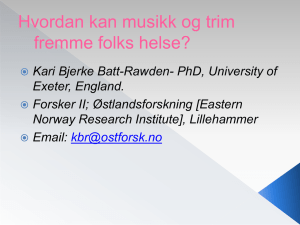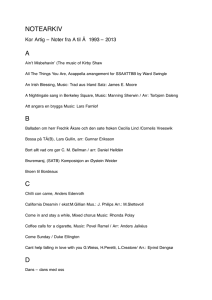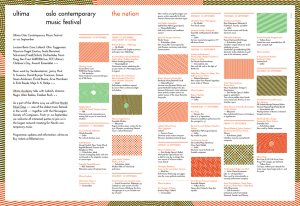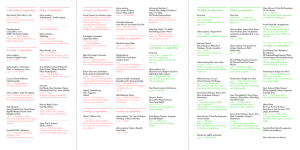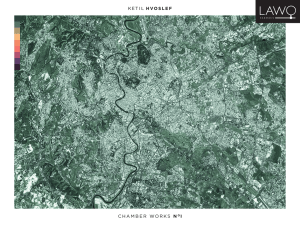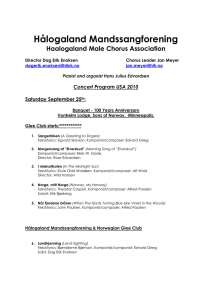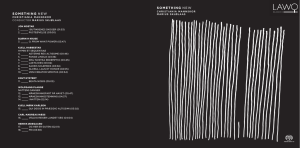e-book
advertisement
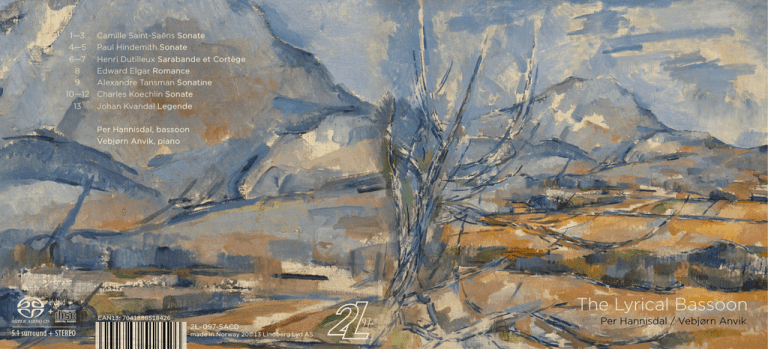
1—3 Camille Saint-Saëns Sonate 4—5 Paul Hindemith Sonate 6—7 Henri Dutilleux Sarabande et Cortège 8 Edward Elgar Romance 9 Alexandre Tansman Sonatine 10—12 Charles Koechlin Sonate 13 eq Johan Kvandal Legende Per Hannisdal, bassoon Vebjørn Anvik, piano The Lyrical Bassoon Hybrid + 5.1 surround + STEREO EAN13: 7041888518426 2L-097-SACD made in Norway 20©13 Lindberg Lyd AS 97 Per Hannisdal / Vebjørn Anvik The Lyrical Bassoon 1 2 3 Camille Saint-Saëns Sonate op. 168 Allegretto moderato 2:37 Allegro scherzando 3:20 Molto adagio – Allegro moderato 5:40 4 5 Paul Hindemith Sonate für Fagott und Klavier Leicht bewegt 2:00 Langsam – Marsch – Beschluss, Pastorale 6:05 6-7 Henri Dutilleux Sarabande et Cortège 6:21 8 Edward Elgar Romance op. 62 4:49 9 Alexandre Tansman Sonatine 7:00 10 11 12 Charles Koechlin Sonate op. 71 Andante moderato – Allegretto scherzando 2:47 Nocturne 3:02 Allegro 3:38 13 Johan Kvandal Legende op. 61b 5:27 Per Hannisdal bassoon Vebjørn Anvik piano This album features some of the finest works in the repertoire for bassoon and piano. Most of them were composed in the first half of the 20th century, which was a fruitful time for music for wind instruments, especially in France. The bassoon, for its part, attracted many composers who were eager to explore all its lyrical and burlesque qualities, often giving full rein to its upper register. One aspect of the prominent role played by musical life in France in this blossoming of music for wind instruments can be seen in the Paris Conservatoire’s tradition of commissioning, from French composers, works to be used in examinations. This resulted in a large number of “pièces de concours” written specifically for different instruments, including the bassoon. These compositions were often works of high quality and they constitute a significant addition to the repertoire. Two examples are to be found on this recording: Dutilleux’s Sarabande et Cortège and Tansman’s Sonatina. Camille Saint-Saëns (1835-1921) composed three sonatas for woodwind instruments (respectively oboe, clarinet and bassoon) and piano in 1921 in Algeria, where he spent the final years of his life. Saint-Saëns was a polymath, distinguishing himself in many fields of scholarship and artistic creativity, as well as being a musical prodigy and an internationally famed virtuoso on the piano and organ. As a composer he held true to classical ideals in an age when new styles were emerging. His music has a strong melodic strain and a clarity of form and texture. The Bassoon Sonata has become a standard work, and, indeed, one of the most popular in the whole repertoire for bassoon and piano. The songlike first movement has an elegance that is typical of the composer. It is followed by a powerful scherzo full of energy and drive, in which characteristic shifts between the major and minor key make for dramatic changes in colour. This movement is in many ways reminiscent of a Mendelssohn scherzo. The first and longest part of the third movement, marked molto adagio, is the emotional heart of the sonata. It exploits the bassoon’s lyrical qualities with expressive melodic lines played over a simple accompaniment, in the classical tradition. This gentle passage is followed by an intensification of the drama before a lively and playful coda concludes both the movement and the work. Paul Hindemith (1895-1963) was a German-born composer, writer, violinist, viola player, teacher and conductor. In the 1930s he found himself in continuous conflict with the Nazis who called his music “degenerate” and “atonal noise”, and he left Germany, settling for a time in Switzerland in 1938, before emigrating to the USA in 1940. Hindemith was profoundly interested in exploring the individual qualities of different instruments and in using them in different combinations in his many chamber works. His Bassoon Sonata (1938) has a melodically flowing first movement, with a secondary theme akin to a siciliano. The second movement opens with a lyrical undulating passage; this is soon interrupted by a burlesque march but, after a while, a quieter and more serious mood returns, and the piece ends with a “Beschluss” – a serene and inward-looking pastorale. Sarabande et Cortège is an early work by Henri Dutilleux (1916-2013) in which the influence of impressionism is clear. The sarabande is a neo-baroque pastiche, with the character of the courtly dance spiced with some refined harmonics. The cortège, which opens with subtle march rhythms, is full of humorous touches, and builds up to a climax of festive exuberance. Edward Elgar (1857-1934) wrote his Romance for bassoon and orchestra in 1910. It was dedicated to Edwin F. James, Principal Bassoon of the London Symphony Orchestra, who gave the first performance. The transcription for piano accompaniment, played on this recording, is by the composer. The piece is characteristic of Elgar’s romantic vein, and is a fine example of his melodic inventiveness, full of warmth, but suggesting at the same time an undercurrent of melancholy. Alexander Tansman (1897-1986) was born in Poland but lived most of his life in France, where he knew Stravinsky and Ravel, both of whom encouraged him in his work as a composer. Tansman’s compositions belong to the neo-classical tradition. In 1941, on account of his Jewish background, he emigrated to the USA. (His compositions include a fair amount of film music for Hollywood.) He returned to live in France in 1946. His Sonatina (1952) opens energetically with percussive drive and syncopated rhythms. The middle movement is a contemplative aria over an ostinato, in neo-baroque style. The final movement returns to the playful, virtuosic mood of the first movement. Charles Koechlin (1867-1950) was a writer and pedagogue as well as a prolific composer. One of his composition teachers was Gabriel Fauré, and Maurice Ravel was a fellow-student. Koechlin’s music embraces a wide range of styles. In his Bassoon Sonata we can detect Faure’s influence in the music’s dreamlike mood, in its multi-faceted palette of sounds and in the richly embroidered piano accompaniment. The Norwegian composer Johan Kvandal (1919-1999), while inspired by his own country’s folk music, was also influenced by musical impulses from continental Europe. He developed a private synthesis he called “modern tonality”. His Legende, Op. 61, originally scored for bassoon and strings, was later transcribed by the composer for bassoon and piano. A songlike main theme alternates with a rhythmically supple motif that is clearly coloured by folkloric traditions. After a cadenza for the bassoon, the piece draws to a close in a slow, nostalgic epilogue. Per Hannisdal (b. 1958) studied the bassoon in Oslo with Arnulf Brachel and Torleiv Nedberg, and in Geneva with Roger Birnstingl. In 1978 he was appointed Principal Bassoon of the Oslo Philharmonic Orchestra. He has appeared as soloist with most of Norway’s orchestras and with orchestras in Denmark, Sweden and Iceland. He also often plays in chamber music ensembles, and has performed in many festivals of chamber music both in Norway and in other countries. He has participated in a large number of CD recordings, sometimes playing a baroque bassoon. He has recorded Vivaldi’s Bassoon Concerto in E minor for 2L. Per Hannisdal also teaches at the Norwegian Academy of Music. On this recording he plays a Heckel bassoon from 1937. Vebjørn Anvik (b. 1962) is a graduate of the Norwegian Academy of Music and of the Ferenc Liszt Academy in Budapest. He has studied the piano with Eline Nygaard and Einar Steen-Nøkleberg, and has participated in master classes with Elisabeth Leonskaja and Hans Leygraf. His debut concert in Oslo in 1981 attracted superlative reviews, and in the ensuing years he has given numerous recitals and appeared as soloist with the leading Norwegian symphony orchestras. In 1993 he received the Levin prize, a highly prestigious award in Norway. He has appeared as soloist and with chamber ensembles at a large number of music festivals in and outside Norway. His recordings include Mozart’s Concerto for two pianos, K 365, with Håvard Gimse as co-soloist and the Norwegian Chamber Orchestra under Iona Brown. In addition to pursuing his busy performing career, he holds an associate professorship at the Norwegian Academy of Music. Vebjørn Anvik has been pianist in the Grieg Trio since it was founded in 1987. The Grieg Trio has played in many parts of the world and has won prizes at home and abroad. The Trio has also made numerous recordings. Vebjørn Anvik Per Hannisdal Denne innspillingen inneholder noen av høydepunktene i litteraturen for fagott og klaver. Musikken er hovedsakelig skrevet i første halvdel av 1900-tallet, en særlig kreativ periode for blåsemusikk, ikke minst i Frankrike. Mange komponister utforsket fagottens lyriske og burleske kvaliteter, og man tok også i bruk instrumentets høye register i rikt monn. Fransk musikklivs betydning for utviklingen av blåserrepertoaret i denne perioden kommer også til uttrykk gjennom Paris – konservatoriets tradisjon for å bestille eksamensstykker fra franske komponister, noe som resulterte i et omfattende utvalg av «pièces de concours» for en rekke instrumenter, deriblant fagott. Dette har gitt et betydelig tilfang av verker av høy kvalitet innenfor denne genren. To eksempler er tatt med i denne innspillingen; Dutilleux´ Sarabande et Cortège og Tansmans Sonatine. Camille Saint-Saëns (1835-1921) skrev tre sonater for treblåsere og klaver – for obo, klarinett og fagott – i 1921 i Algerie, hvor han tilbrakte sine siste år. Saint-Saëns var en multibegavelse, både innen musikk, språk og vitenskap, og en av tidens store klaver- og orgelvirtuoser. Som komponist forble han tro mot de klassiske idealer i en tid med mange ulike stilretninger. Hans musikk har en utpreget melodisk åre og klarhet i form og tekstur. Sonate for fagott og klaver har blitt et standardverk – ett av de mest populære for denne besetningen. Den sangbare førstesatsen har en elegant karakter, typisk for komponisten. Den etterfølges av en virkningsfull scherzo med energisk driv. Her finnes en karakteristisk veksling mellom moll og dur, som gir spennende fargeskift. I mangt kan den gi assosiasjoner til Mendelssohns scherzoer. Tredje sats’ hoveddel – molto adagio – utgjør sonatens uttrykksmessige høydepunkt. Den utnytter fagottens lyriske kvaliteter, med uttrykksfulle melodiske linjer over et enkelt akkompagnement, i klassisk stil. Etter en dramatisk stigning munner satsen (og verket) ut i en frisk, utadvendt og lekende coda. Paul Hindemith (1895-1963) var tyskfødt komponist, skribent, fiolinist, bratsjist, pedagog og dirigent. I 1930-årene kom han på kant med naziregimet, som kalte hans musikk «degenerert» og «atonalt bråk». Han emigrerte til Sveits i 1938, og til USA i 1940. Hindemith hadde genuin interesse for ulike instrumenters egenart, og skrev kammermusikkverker for svært mange instrumentkombinasjoner. Sonate for fagott og klaver (1938) har en sangbar og bevegelig førstesats, med et siciliano-preget sidetema. Andre sats innledes med en lyrisk, klanglig svevende sekvens, som snart avbrytes av en burlesk marsj, for så å vende tilbake til en alvorlig «Beschluss» – en vakker og innadvendt pastorale. Sarabande et Cortège (1942) er et tidlig verk av Henri Dutilleux (1916-2013), og man sporer tydelig påvirkning fra impresjonistene. Sarabanden er en neo-barokk pastisj, med denne hoffdansens grunnkarakter, krydret med raffinert harmonikk. Cortège åpner med underfundige marsjrytmer, er full av humoristiske innfall, og topper seg i et feststemt klimaks. Edward Elgar (1857-1934) skrev sin Romance for fagott og orkester i 1910. Den ble tilegnet solofagottist Edwin F. James i London Symphony Orchestra, som også urfremførte den. Versjonen med klaverakkompagnement er Elgars egen. Stykket er karakteristisk for Elgars romantiske uttrykk. Det er et fint eksempel på komponistens overskudd av melodisk fantasi, og preget av stor varme, med en understrøm av melankoli. Alexandre Tansman (1897-1986) var født i Polen, men levde mesteparten av sitt liv i Frankrike, hvor han kom i kontakt med og ble oppmuntret av Ravel og Stravinskij. Han skrev innenfor en neo-klassisk stilretning. I 1941 emigrerte han til USA pga. sin jødiske bakgrunn. (Tansman har også komponert musikk til flere Hollywood-filmer). I 1946 returnerte han til Frankrike. Sonatine (1952) åpner energisk, med perkusivt driv og synkoperte rytmer. Midtsatsen er en kontemplativ aria over et ostinato, i neobarokk stil. Siste sats vender tilbake til det utadvendte, lekende og virtuose. Charles Koechlin (1867-1950) virket, foruten som komponist, også som pedagog og skribent. Hans lærer i komposisjon var bl.a. Gabriel Fauré og Ravel en av medstudentene. Han var meget produktiv, og hans musikk beveger seg innenfor flere stilretninger. I Sonate for fagott og klaver aner vi påvirkning fra læremesteren Fauré, i musikkens drømmende atmosfære, mangefasetterte klangbilde, og ved den rikt utbroderte klaversatsen. Johan Kvandal (1919-1999) var inspirert av norsk folkemusikk, men hentet også impulser fra kontinentet. Han utviklet etter hvert en personlig syntese han selv kalte «moderne tonalitet». Legende op. 61 er opprinnelig skrevet for fagott og strykere, senere transkribert av komponisten for fagott og klaver. Et sangbart hovedtema veksler med et rytmisk spenstig, folkloristisk farget motiv. Etter en solokadens for fagotten toner stykket ut med en langsom nostalgisk epilog. Per Hannisdal (1958) studerte fagott i Oslo med Arnulf Brachel og Torleiv Nedberg og med Roger Birnstingl i Geneve, og ble i 1978 ansatt som solofagottist i Oslo Filharmoniske Orkester. Per Hannisdal har hatt solistoppgaver med de fleste norske orkestre og med orkestre i Danmark, Sverige og Island. Han er også en svært aktiv kammermusiker og har spilt på en rekke kammermusikkfestivaler i Norge og i utlandet. Han har medvirket på mange CD-innspillinger, også på barokkfagott, og har spilt inn Vivaldis fagottkonsert i E-moll på 2L. Per Hannisdal underviser på Norges musikkhøgskole. På denne CD-en spiller han på en «Heckel»-fagott fra 1937. Vebjørn Anvik (1962) er utdannet ved Norges musikkhøgskole i Oslo og Ferenc Liszt-Akademiet i Budapest. Han har studert klaver med Eline Nygaard og Einar Steen-Nøkleberg, samt i mesterklasser med Elisabeth Leonskaja og Hans Leygraf. Han hadde sin debutkonsert i Oslo i 1981, til glimrende kritikker, og har i ettertid gitt en rekke solo recitaler og stått frem som solist med ledende norske symfoniorkestre. I 1993 fikk Vebjørn Anvik den høythengende Levin-prisen (Norge) for sitt klaverspill. Han har opptrådt som solist og kammermusiker ved en rekke norske og europeiske musikkfestivaler. CD-innspillinger inkluderer bl.a. Mozarts konsert for to klaver KV 365 på Chandos med Håvard Gimse, Det Norske Kammerorkester og Iona Brown. Han er, foruten sitt virke som frilans-musiker, ansatt som førsteamanuensis ved Norges musikkhøgskole. Vebjørn Anvik er pianist i Grieg Trio (etablert 1987), og har med dette ensemblet turnert over store deler av verden, vunnet en rekke nasjonale og internasjonale priser samt gjort flere CD-innspillinger. Recorded at Jar Church, Norway April 30th–May 3rd 2012 by Lindberg Lyd AS Recording Producer JØRN SIMENSTAD Balance Engineer MORTEN LINDBERG Recording Technician BEATRICE JOHANNESSEN Piano Technician THRON IRBY Steinway Editing JØRN SIMENSTAD Mix and Mastering MORTEN LINDBERG Artwork “Montagne Sainte-Victoire” (1890-1895) PAUL CÉZANNE Photo Per Hannisdal and the duo SJØWALL Photo Vebjørn Anvik HANS BROX Text PER HANNISDAL and VEBJØRN ANVIK Translation RICHARD HUGH PEEL Graphic design MORTEN LINDBERG Financially supported by Fond For Utøvende Kunstnere and Fond For Lyd og Bilde Executive Producer JØRN SIMENSTAD www.2L.no 2L is the exclusive and registered trade mark of Lindberg Lyd AS 20©13 [NOMPP1309010-130] 2L-097-SACD This recording was made with DPA microphones, Millennia Media amplifiers and SPHYNX2 converters to a PYRAMIX workstation, all within the DXD-domain. Digital eXtreme Definition is a professional audio format that brings "analogue" qualities in 24 bit at 352.8 kHz sampling rate. With DXD we preserve 8.4672 Mbit/s per channel linear PCM. This leaves headroom for editing and balancing before quantizing to DSD. Super Audio CD is the carrier that brings the pure quality to the domestic audience. www.lindberg.no
